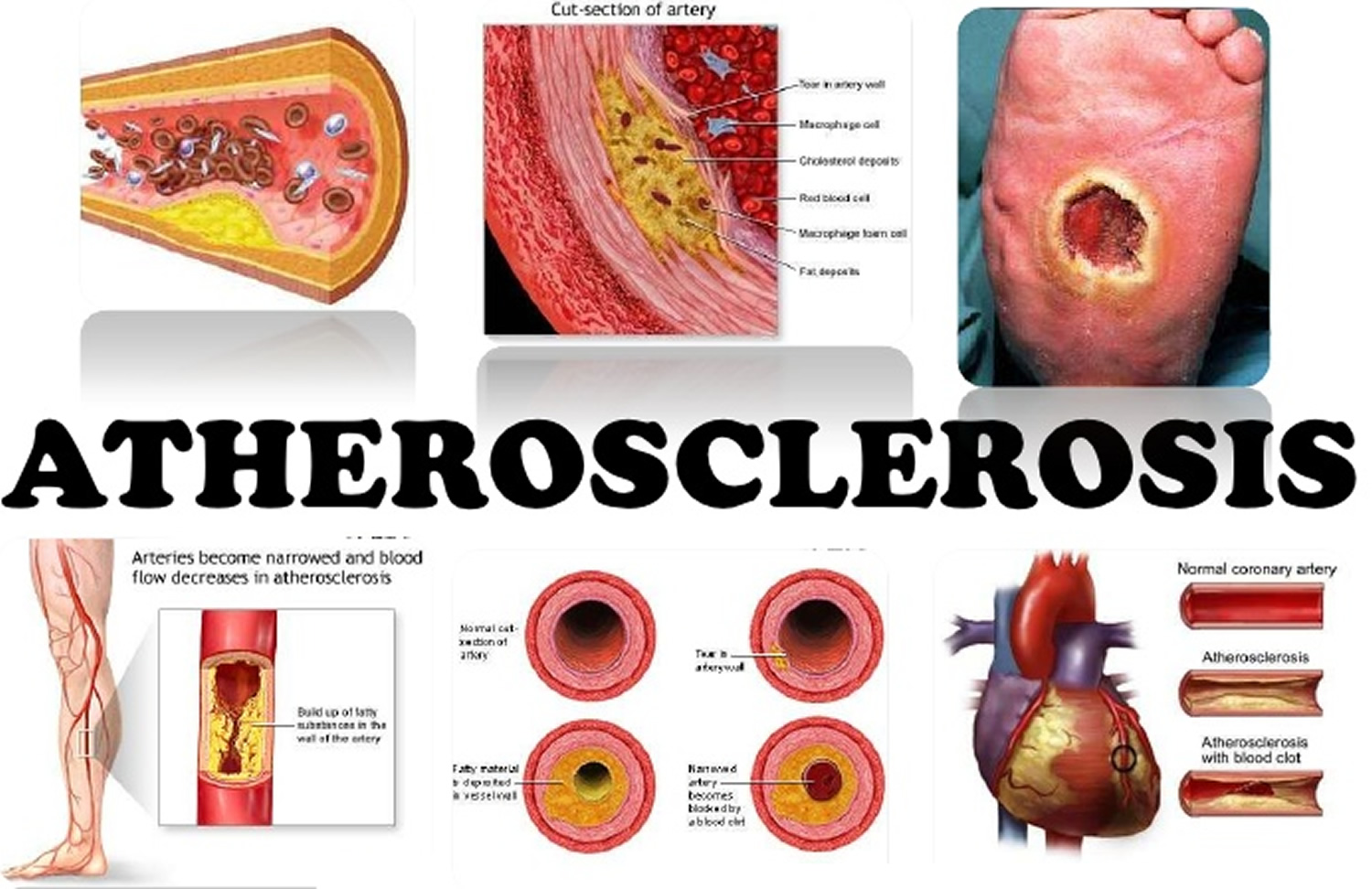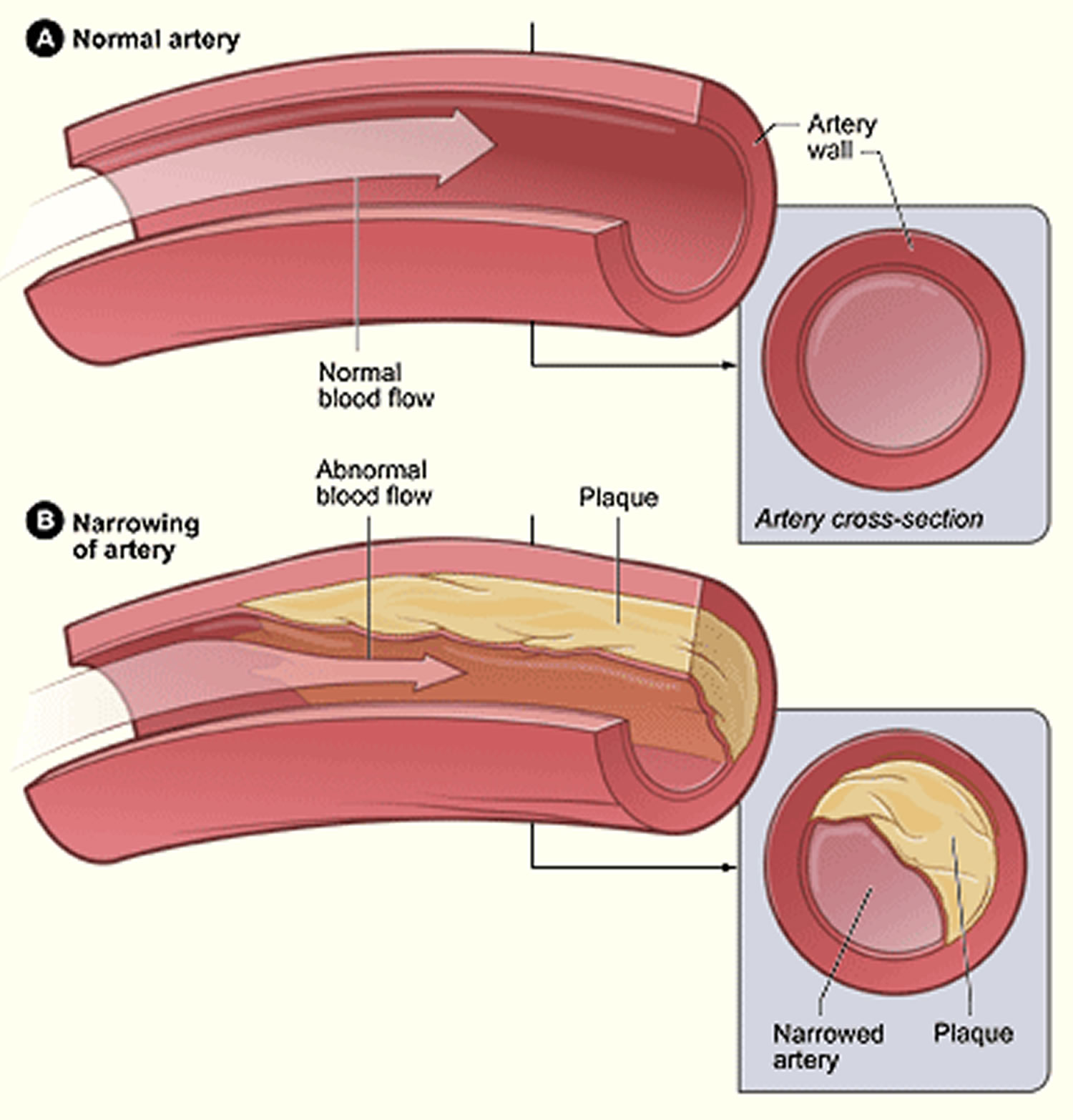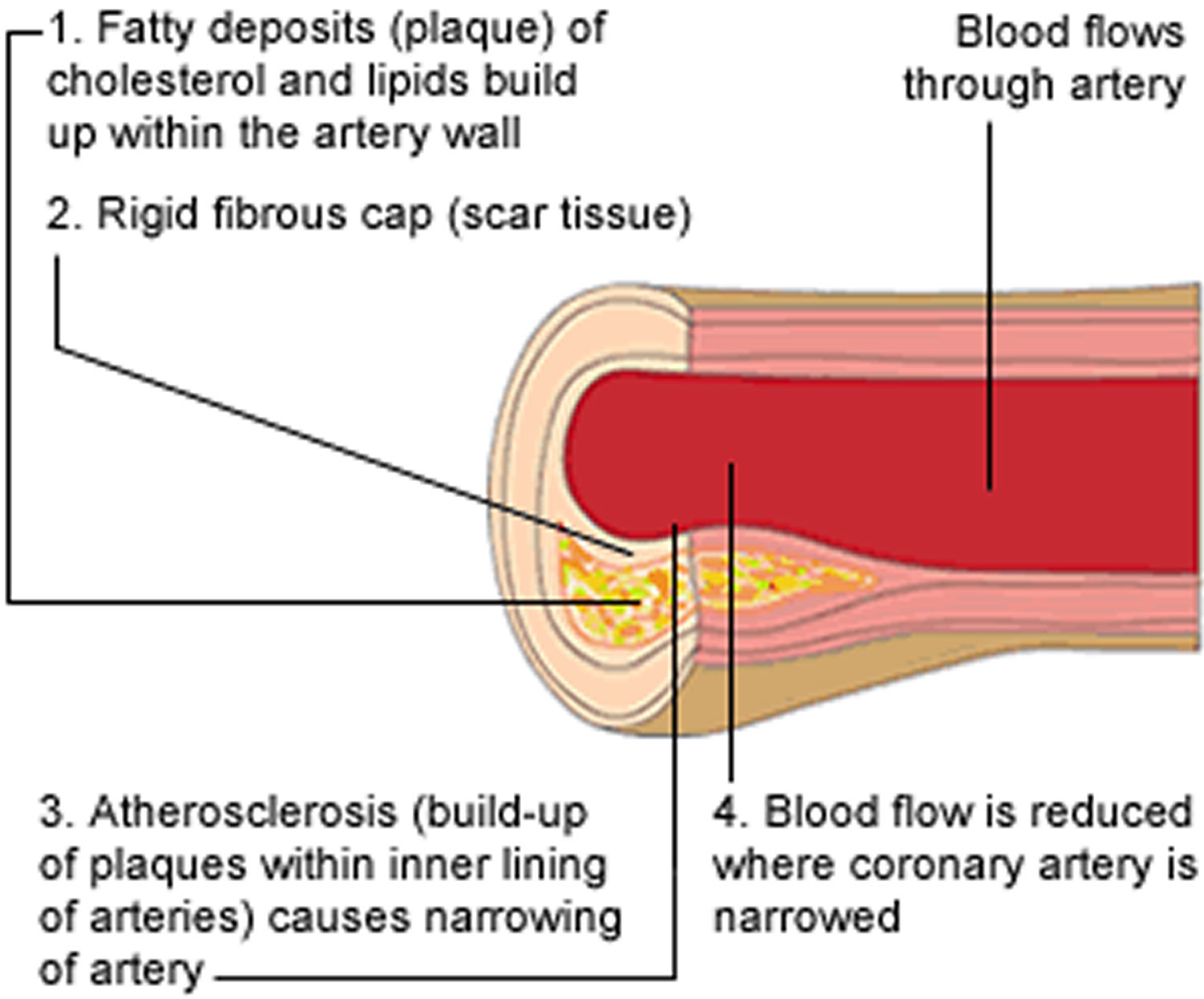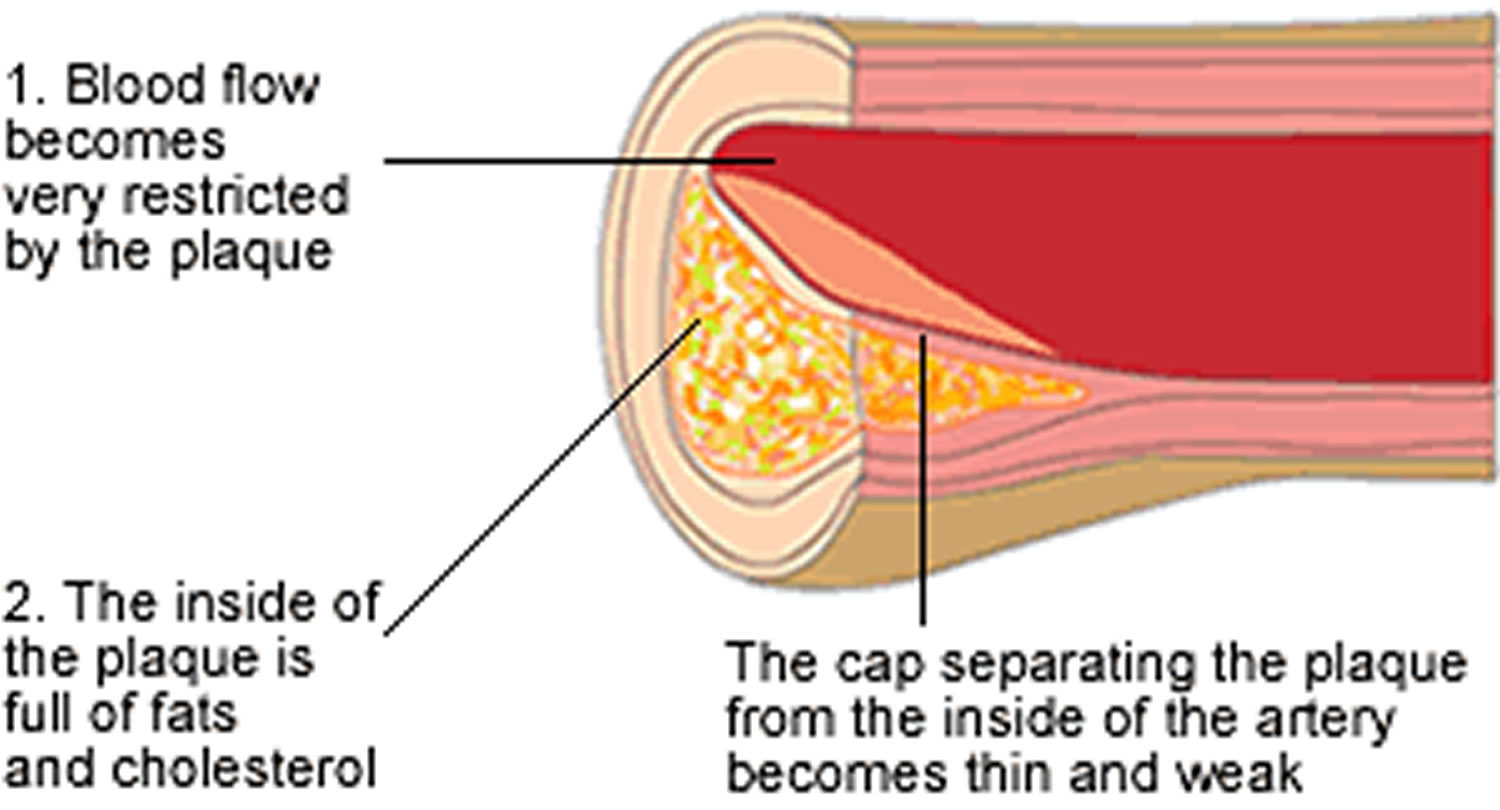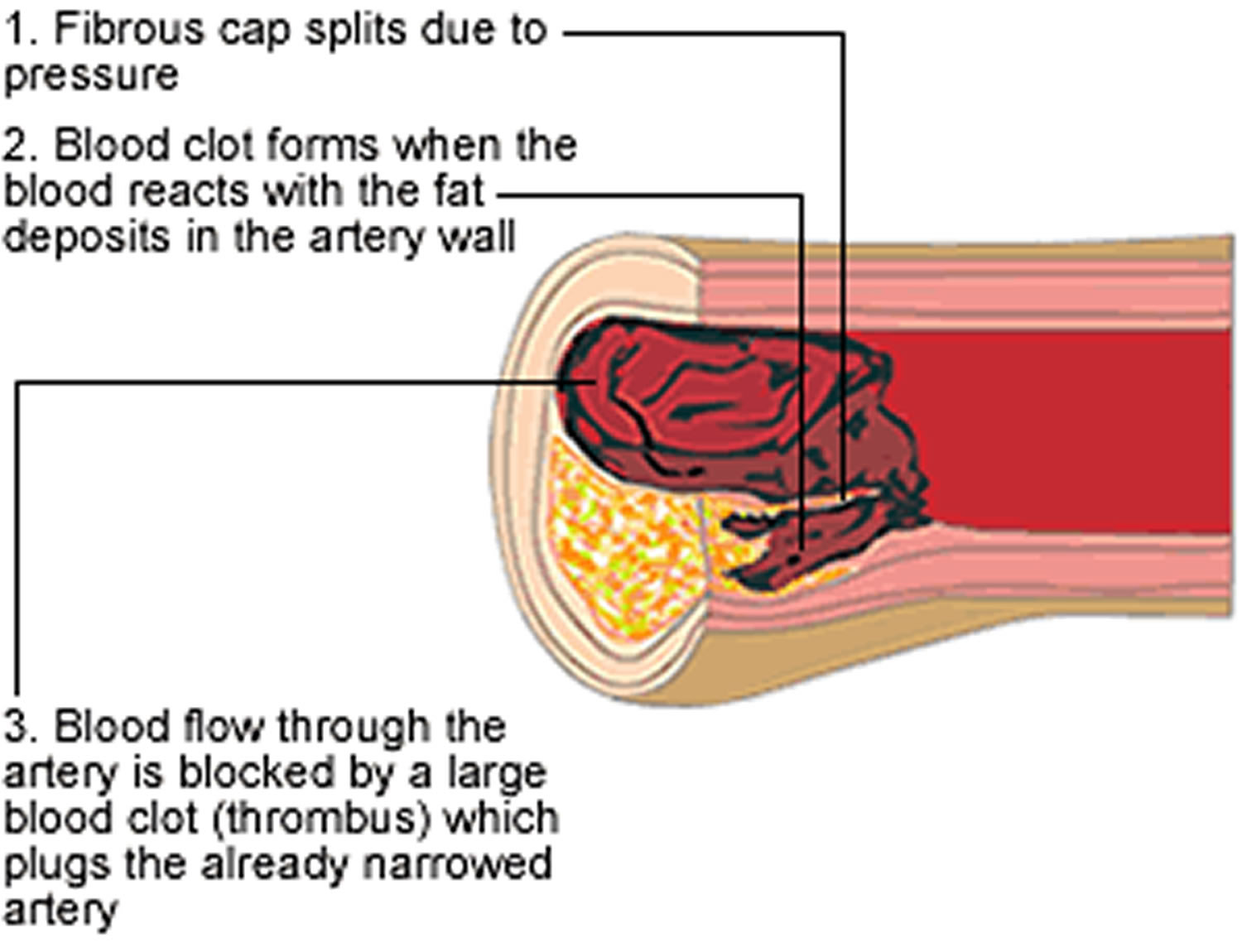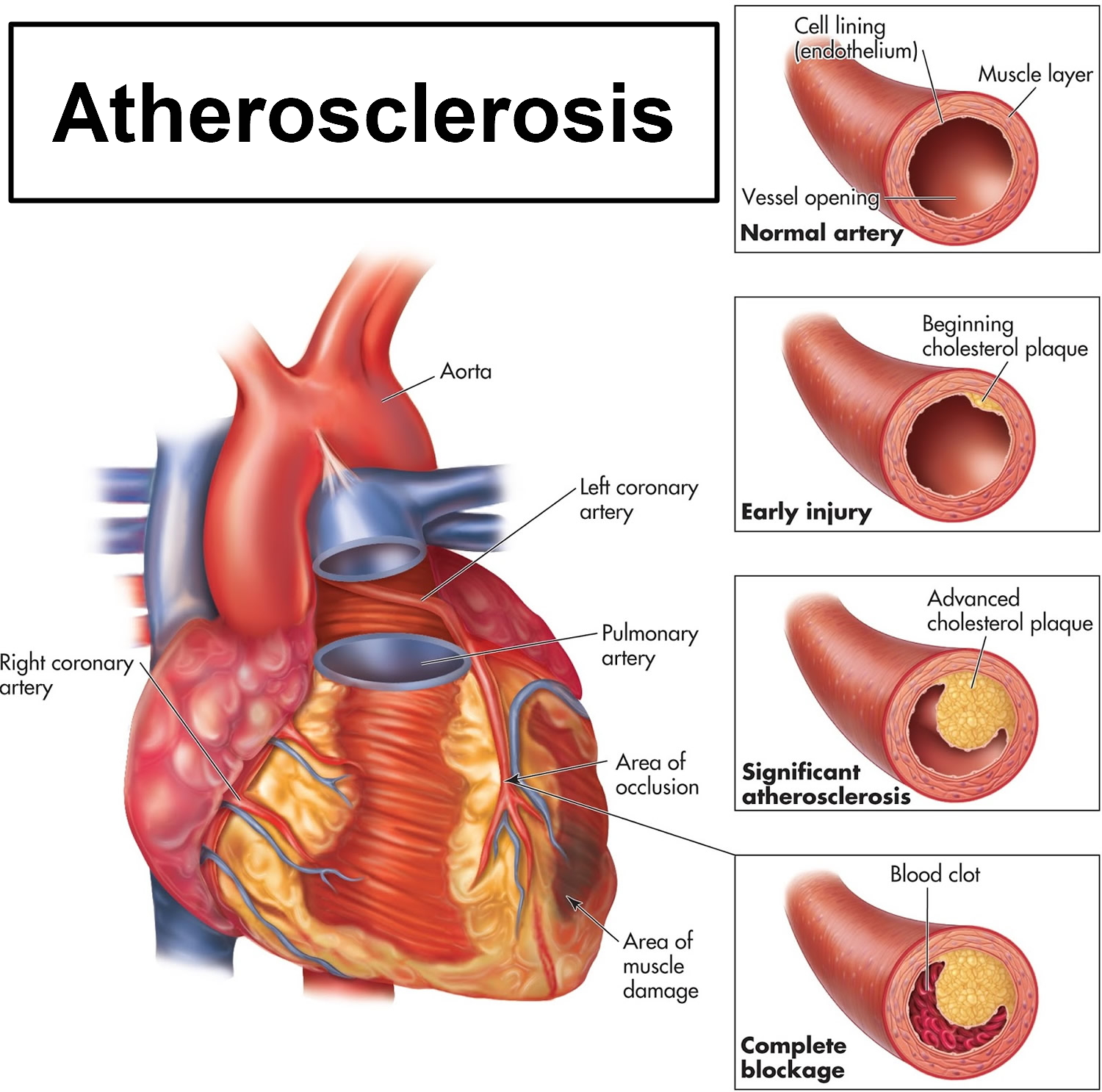Contents
- What is atherosclerosis
- Atherosclerosis-Related Diseases
- Atherosclerosis outlook (prognosis)
- Atherosclerosis vs Arteriosclerosis
- Atherosclerosis complications
- Atherosclerosis causes
- Atherosclerosis risk factors
- Atherosclerosis prevention
- Reversing atherosclerosis
- Atherosclerosis symptoms
- Atherosclerosis diagnosis
- Atherosclerosis treatment
What is atherosclerosis
Atherosclerosis (also known as hardening of the arteries or stiffening of the arteries or arteriosclerosis) is a disease in which plaque builds up inside your arteries. Atherosclerosis can lead to serious problems, including heart attack, stroke, or even death. Arteries are blood vessels that carry oxygen-rich blood to your heart and other parts of your body. Atherosclerosis is a disease of the blood vessels (the arteries) that carry blood and oxygen from the heart to the rest of the body. The arteries are normally quite flexible, but over many years, the artery walls gradually lose their elasticity. The walls become hardened and stiff due to the build-up of a substance called plaque that is rich in cholesterol.
Cholesterol is a fatty substance that is made by the body but which is also found in some foods. High levels in the blood of a type of cholesterol (called ‘bad’ cholesterol, or LDL-cholesterol) increases the risk of developing heart disease, including atherosclerosis. Estimates suggest that around a third of the adult Australian population has high levels of cholesterol.
Plaque is made up of fat, bad cholesterol, calcium, white blood cells and other substances found in the blood that slowly and silently builds up inside the walls of the arteries. As the plaque grows over many years, it can begin to interfere with the flow of blood through the artery. This limits the flow of oxygen-rich blood to your organs and other parts of your body. Atherosclerosis can affect arteries anywhere in the body, and these plaques can burst, triggering a blood clot which may lead to a serious medical emergency, such as a heart attack, stroke or even death. In severe cases, the flow of blood can be completely blocked.
The cause of atherosclerosis isn’t known. However, certain traits, conditions, or habits may raise your risk for the disease. These conditions are known as risk factors. For example, the development of plaque is affected by what you eat, your weight, how much physical activity you do, and whether you’re a smoker. It is also affected by your age and gender, and whether you have a history of high cholesterol in your family.
You can control some risk factors, such as lack of physical activity, smoking, and an unhealthy diet. Others you can’t control, such as age and a family history of heart disease.
Some people who have atherosclerosis have no signs or symptoms. They may not be diagnosed until after a heart attack or stroke.
The main treatment for atherosclerosis is lifestyle changes. You also may need medicines and medical procedures. These treatments, along with ongoing medical care, can help you live a healthier life.
Figure 1. Atherosclerosis
There are 3 main stages in the development of atherosclerosis:
Stage 1 – Plaque builds up in an artery (Figure 2)
The inside lining of a healthy artery is normally smooth to make it easy for blood to flow. However, if the inner lining of the artery becomes damaged – for example, due to high cholesterol, high blood pressure or smoking – it allows plaque to start accumulating within the artery wall.
Over time, a tough, fibrous cap or scar forms over the top of the plaque, so that the mixture of ‘bad’ cholesterol, fats (lipids), calcium and white blood cells is kept separate from the blood.
The growth of the plaque can narrow the artery, which reduces the flow of blood through the artery.
Figure 2. Atherosclerosis development stage 1
Stage 2 – The plaque gets bigger and becomes unstable (Figure 3)
There are different types of plaque. Some plaques grow slowly and may never cause any symptoms, even if the plaque is large enough to severely restrict blood flow through the artery.
The most dangerous type of plaque is called unstable plaque. In these plaques, the tough fibrous cap on top of the cholesterol-rich plaque becomes thin and weak, which makes it more likely to burst.
Figure 3. Atherosclerosis development stage 2
Stage 3 – The plaque bursts and a blood clot blocks the artery (Figure 4)
Narrowing of the artery due to the build-up of plaque makes it harder for blood to flow through the artery. Forcing the blood through a narrower space increases blood pressure in the artery, which can tear open the fibrous cap of the unstable plaque.
As the cap bursts, the contents of the plaque – including cholesterol, fats, and white blood cells – are released into the blood. This can trigger the development of a large blood clot (or thrombus) which can completely block the already narrowed artery.
Depending on where the blockage occurs, the blood clot can cause a medical emergency, such as a heart attack (if an artery supplying the heart becomes blocked) or a stroke (if the blockage affects an artery supplying the brain).
Figure 4. Atherosclerosis development stage 3
Which arteries can be affected by atherosclerosis?
Atherosclerosis can affect any artery in the body, and the outcome depends on where the affected artery is located.
Some of the important sites of atherosclerosis include:
- The coronary arteries which supply blood to the heart (coronary atherosclerosis) – A build-up up of plaque in these coronary arteries can reduce the flow of blood to the muscles of the heart (see Figure 5 below). This can cause pain or discomfort (called angina) in the chest, shoulders, neck, jaw or arms. A heart attack may occur if a coronary artery becomes completely blocked due to a blood clot.
- The peripheral arteries which supply blood to your arms, legs, and pelvis – Narrowing or blockage of these major blood vessels is called peripheral arterial disease and can result in numbness or pain in the limbs, including pain in the legs when walking or climbing stairs (called claudication). Reduced blood flow to the toes, feet, and legs increases the risk of poorly healing wounds and infections in these areas. If blood flow is severely restricted, tissues in the lower parts of the limbs may rot and die (called gangrene) and need to be amputated.
- The carotid arteries on either side of your neck that supply blood and oxygen to your brain – Narrowing or blockage of these arteries can lead to a stroke. Symptoms of a stroke can include sudden weakness, paralysis, confusion, difficulty speaking, or loss of consciousness.
- The renal arteries which supply your kidneys with blood – If these arteries become narrowed or blocked, you may develop kidney disease, which means your body can’t effectively get rid of wastes and excess fluid. Symptoms of kidney disease can include changes in urination, loss of appetite, feeling sick, difficulty concentrating, and swollen hands or feet.
Figure 5. Coronary artery atherosclerosis
Atherosclerosis-Related Diseases
Atherosclerosis can affect any artery in the body, including arteries in the heart, brain, arms, legs, pelvis, and kidneys. As a result, different diseases may develop based on which arteries are affected.
Coronary artery atherosclerosis
Coronary artery disease is also called coronary heart disease, occurs when plaque builds up in the coronary arteries. These arteries supply oxygen-rich blood to your heart.
Plaque narrows the coronary arteries and reduces blood flow to your heart muscle. Plaque buildup also makes it more likely that blood clots will form in your arteries. Blood clots can partially or completely block blood flow.
If blood flow to your heart muscle is reduced or blocked, you may have angina (chest pain or discomfort) or a heart attack.
Plaque also can form in the heart’s smallest arteries. This disease is called coronary microvascular disease. In coronary microvascular disease, plaque doesn’t cause blockages in the arteries as it does in coronary artery disease.
Carotid atherosclerosis
Carotid artery disease occurs if plaque builds up in the arteries on each side of your neck (the carotid arteries). These arteries supply oxygen-rich blood to your brain. If blood flow to your brain is reduced or blocked, you may have a stroke.
Peripheral Artery Disease
Peripheral artery disease occurs if plaque builds up in the major arteries that supply oxygen-rich blood to your legs, arms, and pelvis.
If blood flow to these parts of your body is reduced or blocked, you may have numbness, pain, and, sometimes, dangerous infections.
Chronic Kidney Disease
Chronic kidney disease can occur if plaque builds up in the renal arteries. These arteries supply oxygen-rich blood to your kidneys.
Over time, chronic kidney disease causes a slow loss of kidney function. The main function of the kidneys is to remove waste and extra water from the body.
Atherosclerosis outlook (prognosis)
Improved treatments have reduced the number of deaths from atherosclerosis-related diseases. These treatments also have improved the quality of life for people who have these diseases. However, atherosclerosis remains a common health problem.
You may be able to prevent or delay atherosclerosis and the diseases it can cause. Making lifestyle changes and getting ongoing care can help you avoid the problems of atherosclerosis and live a long, healthy life.
Atherosclerosis vs Arteriosclerosis
Atherosclerosis is also known as arteriosclerosis.
Atherosclerosis complications
The complications of atherosclerosis depend on which arteries are blocked. For example:
- Coronary artery disease. When atherosclerosis narrows the arteries close to your heart, you may develop coronary artery disease, which can cause chest pain (angina), a heart attack or heart failure.
- Carotid artery disease. When atherosclerosis narrows the arteries close to your brain, you may develop carotid artery disease, which can cause a transient ischemic attack (TIA) or stroke.
- Peripheral artery disease. When atherosclerosis narrows the arteries in your arms or legs, you may develop circulation problems in your arms and legs called peripheral artery disease. This can make you less sensitive to heat and cold, increasing your risk of burns or frostbite. In rare cases, poor circulation in your arms or legs can cause tissue death (gangrene).
- Aneurysms. Atherosclerosis can also cause aneurysms, a serious complication that can occur anywhere in your body. An aneurysm is a bulge in the wall of your artery. Most people with aneurysms have no symptoms. Pain and throbbing in the area of an aneurysm may occur and is a medical emergency. If an aneurysm bursts, you may face life-threatening internal bleeding. Although this is usually a sudden, catastrophic event, a slow leak is possible. If a blood clot within an aneurysm dislodges, it may block an artery at some distant point.
- Chronic kidney disease. Atherosclerosis can cause the arteries leading to your kidneys to narrow, preventing oxygenated blood from reaching them. Over time, this can affect your kidney function, keeping waste from exiting your body.
Atherosclerosis causes
What causes atherosclerosis
The exact cause of atherosclerosis isn’t known. However, studies show that atherosclerosis is a slow, complex disease that may start in childhood. Atherosclerosis develops faster as you age.
Atherosclerosis may start when certain factors damage the inner layers of the arteries. These factors include:
- Smoking
- High amounts of certain fats and cholesterol in the blood
- High blood pressure
- High amounts of sugar in the blood due to insulin resistance or diabetes
Plaque may begin to build up where the arteries are damaged. Over time, plaque hardens and narrows the arteries. Eventually, an area of plaque can rupture (break open).
When this happens, blood cell fragments called platelets stick to the site of the injury. They may clump together to form blood clots. Clots narrow the arteries even more, limiting the flow of oxygen-rich blood to your body.
Depending on which arteries are affected, blood clots can worsen angina (chest pain) or cause a heart attack or stroke.
Researchers continue to look for the causes of atherosclerosis. They hope to find answers to questions such as:
- Why and how do the arteries become damaged?
- How does plaque develop and change over time?
- Why does plaque rupture and lead to blood clots?
Atherosclerosis risk factors
The exact cause of atherosclerosis isn’t known. However, certain traits, conditions, or habits may raise your risk for the disease. These conditions are known as risk factors. The more risk factors you have, the more likely it is that you’ll develop atherosclerosis.
You can control most risk factors and help prevent or delay atherosclerosis. Other risk factors can’t be controlled.
Major Risk Factors for atherosclerosis
- Unhealthy blood cholesterol levels. This includes high LDL cholesterol (sometimes called “bad” cholesterol) and low HDL cholesterol (sometimes called “good” cholesterol).
- High blood pressure (hypertension). Blood pressure is considered high if it stays at or above 140/90 mmHg over time. If you have diabetes or chronic kidney disease, high blood pressure is defined as 130/80 mmHg or higher. (The mmHg is millimeters of mercury—the units used to measure blood pressure.)
- Smoking. Smoking can damage and tighten blood vessels, raise cholesterol levels, and raise blood pressure. Smoking also doesn’t allow enough oxygen to reach the body’s tissues.
- Insulin resistance. This condition occurs if the body can’t use its insulin properly. Insulin is a hormone that helps move blood sugar into cells where it’s used as an energy source. Insulin resistance may lead to diabetes.
- Diabetes. With this disease, the body’s blood sugar level is too high because the body doesn’t make enough insulin or doesn’t use its insulin properly.
- Overweight or obesity. The terms “overweight” and “obesity” refer to body weight that’s greater than what is considered healthy for a certain height.
- Lack of physical activity. A lack of physical activity can worsen other risk factors for atherosclerosis, such as unhealthy blood cholesterol levels, high blood pressure, diabetes, and overweight and obesity.
- Unhealthy diet. An unhealthy diet can raise your risk for atherosclerosis. Foods that are high in saturated and trans fats, cholesterol, sodium (salt), and sugar can worsen other atherosclerosis risk factors.
- Older age. As you get older, your risk for atherosclerosis increases. Genetic or lifestyle factors cause plaque to build up in your arteries as you age. By the time you’re middle-aged or older, enough plaque has built up to cause signs or symptoms. In men, the risk increases after age 45. In women, the risk increases after age 55.
- Family history of early heart disease. Your risk for atherosclerosis increases if your father or a brother was diagnosed with heart disease before 55 years of age, or if your mother or a sister was diagnosed with heart disease before 65 years of age.
Although age and a family history of early heart disease are risk factors, it doesn’t mean that you’ll develop atherosclerosis if you have one or both. Controlling other risk factors often can lessen genetic influences and prevent atherosclerosis, even in older adults.
Studies show that an increasing number of children and youth are at risk for atherosclerosis. This is due to a number of causes, including rising childhood obesity rates.
Emerging risk factors for atherosclerosis
Scientists continue to study other possible risk factors for atherosclerosis.
- High levels of a protein called C-reactive protein (CRP) in the blood may raise the risk for atherosclerosis and heart attack. High levels of CRP are a sign of inflammation in the body. Inflammation is the body’s response to injury or infection. Damage to the arteries’ inner walls seems to trigger inflammation and help plaque grow. People who have low CRP levels may develop atherosclerosis at a slower rate than people who have high CRP levels. Research is under way to find out whether reducing inflammation and lowering CRP levels also can reduce the risk for atherosclerosis.
- High levels of triglyceride in the blood also may raise the risk for atherosclerosis, especially in women. Triglycerides are a type of fat.
Studies are under way to find out whether genetics may play a role in atherosclerosis risk.
Other factors that affect atherosclerosis
Other factors also may raise your risk for atherosclerosis, such as:
- Sleep apnea. Sleep apnea is a disorder that causes one or more pauses in breathing or shallow breaths while you sleep. Untreated sleep apnea can raise your risk for high blood pressure, diabetes, and even a heart attack or stroke.
- Stress. Research shows that the most commonly reported “trigger” for a heart attack is an emotionally upsetting event, especially one involving anger.
- Alcohol. Heavy drinking can damage the heart muscle and worsen other risk factors for atherosclerosis. Men should have no more than two drinks containing alcohol a day. Women should have no more than one drink containing alcohol a day.
Atherosclerosis prevention
Taking action to control your risk factors can help prevent or delay atherosclerosis and its related diseases. Your risk for atherosclerosis increases with the number of risk factors you have.
One step you can take is to adopt a healthy lifestyle, which can include:
- Heart-Healthy Eating. Adopt heart-healthy eating habits, which include eating different fruits and vegetables (including beans and peas), whole grains, lean meats, poultry without skin, seafood, and fat-free or low-fat milk and dairy products. A heart-healthy diet is low in sodium, added sugar, solid fats, and refined grains. Following a heart-healthy diet is an important part of a healthy lifestyle.
- Physical Activity. Be as physically active as you can. Physical activity can improve your fitness level and your health. Ask your doctor what types and amounts of activity are safe for you. Read more about Physical Activity and Your Heart.
- Quit Smoking. If you smoke, quit. Smoking can damage and tighten blood vessels and raise your risk for atherosclerosis. Talk with your doctor about programs and products that can help you quit. Also, try to avoid secondhand smoke. Read more about Smoking and Your Heart.
- Weight Control. If you’re overweight or obese, work with your doctor to create a reasonable weight-loss plan. Controlling your weight helps you control risk factors for atherosclerosis.
Other steps that can prevent or delay atherosclerosis include knowing your family history of atherosclerosis. If you or someone in your family has an atherosclerosis-related disease, be sure to tell your doctor.
If lifestyle changes aren’t enough, your doctor may prescribe medicines to control your atherosclerosis risk factors. Take all of your medicines as your doctor advises.
Reversing atherosclerosis
Atherosclerosis can’t be stopped and current treatments can’t reverse it. But there are things that can slow down its progress and dramatically lower your chances of a heart attack or stroke. Medicines can help to do this. Having a healthy lifestyle and managing your risk factors is vital too.
Atherosclerosis symptoms
Atherosclerosis usually doesn’t cause signs and symptoms until it severely narrows or totally blocks an artery. Many people don’t know they have the disease until they have a medical emergency, such as a heart attack or stroke.
Some people may have signs and symptoms of the disease. Signs and symptoms will depend on which arteries are affected.
Coronary Arteries
The coronary arteries supply oxygen-rich blood to your heart. If plaque narrows or blocks these arteries (a disease called coronary heart disease, or coronary heart disease), a common symptom is angina. Angina is chest pain or discomfort that occurs when your heart muscle doesn’t get enough oxygen-rich blood.
Angina may feel like pressure or squeezing in your chest. You also may feel it in your shoulders, arms, neck, jaw, or back. Angina pain may even feel like indigestion. The pain tends to get worse with activity and go away with rest. Emotional stress also can trigger the pain.
Other symptoms of coronary heart disease are shortness of breath and arrhythmias. Arrhythmias are problems with the rate or rhythm of the heartbeat.
Plaque also can form in the heart’s smallest arteries. This disease is called coronary microvascular disease. Symptoms of coronary microvascular disease include angina, shortness of breath, sleep problems, fatigue (tiredness), and lack of energy.
Carotid Arteries
The carotid arteries supply oxygen-rich blood to your brain. If plaque narrows or blocks these arteries (a disease called carotid artery disease), you may have symptoms of a stroke. These symptoms may include:
- Sudden weakness
- Paralysis (an inability to move) or numbness of the face, arms, or legs, especially on one side of the body
- Confusion
- Trouble speaking or understanding speech
- Trouble seeing in one or both eyes
- Problems breathing
- Dizziness, trouble walking, loss of balance or coordination, and unexplained falls
- Loss of consciousness
- Sudden and severe headache
Peripheral Arteries
Plaque also can build up in the major arteries that supply oxygen-rich blood to the legs, arms, and pelvis (a disease called peripheral artery disease).
If these major arteries are narrowed or blocked, you may have numbness, pain, and, sometimes, dangerous infections.
Renal Arteries
The renal arteries supply oxygen-rich blood to your kidneys. If plaque builds up in these arteries, you may develop chronic kidney disease. Over time, chronic kidney disease causes a slow loss of kidney function.
Early kidney disease often has no signs or symptoms. As the disease gets worse it can cause tiredness, changes in how you urinate (more often or less often), loss of appetite, nausea (feeling sick to the stomach), swelling in the hands or feet, itchiness or numbness, and trouble concentrating.
Atherosclerosis diagnosis
Your doctor will diagnose atherosclerosis based on your medical and family histories, a physical exam, and test results.
Specialists Involved
If you have atherosclerosis, a primary care doctor, such as an internist or family practitioner, may handle your care. Your doctor may recommend other health care specialists if you need expert care, such as:
- A cardiologist. This is a doctor who specializes in diagnosing and treating heart diseases and conditions. You may go to a cardiologist if you have peripheral artery disease or coronary microvascular disease.
- A vascular specialist. This is a doctor who specializes in diagnosing and treating blood vessel problems. You may go to a vascular specialist if you have peripheral artery disease.
- A neurologist. This is a doctor who specializes in diagnosing and treating nervous system disorders. You may see a neurologist if you’ve had a stroke due to carotid artery disease.
- A nephrologist. This is a doctor who specializes in diagnosing and treating kidney diseases and conditions. You may go to a nephrologist if you have chronic kidney disease.
Physical Exam
During the physical exam, your doctor may listen to your arteries for an abnormal whooshing sound called a bruit. Your doctor can hear a bruit when placing a stethoscope over an affected artery. A bruit may indicate poor blood flow due to plaque buildup.
Your doctor also may check to see whether any of your pulses (for example, in the leg or foot) are weak or absent. A weak or absent pulse can be a sign of a blocked artery.
Diagnostic Tests
Your doctor may recommend one or more tests to diagnose atherosclerosis. These tests also can help your doctor learn the extent of your disease and plan the best treatment.
Blood Tests
Blood tests check the levels of certain fats, cholesterol, sugar, and proteins in your blood. Abnormal levels may be a sign that you’re at risk for atherosclerosis.
EKG (Electrocardiogram)
An EKG or ECG is a simple, painless test that detects and records the heart’s electrical activity. The test shows how fast the heart is beating and its rhythm (steady or irregular). An EKG also records the strength and timing of electrical signals as they pass through the heart.
An EKG can show signs of heart damage caused by coronary heart disease. The test also can show signs of a previous or current heart attack.
Chest X Ray
A chest x ray takes pictures of the organs and structures inside your chest, such as your heart, lungs, and blood vessels. A chest x ray can reveal signs of heart failure.
Ankle/Brachial Index
This test compares the blood pressure in your ankle with the blood pressure in your arm to see how well your blood is flowing. This test can help diagnose peripheral artery disease.
Echocardiography
Echocardiography (echo) uses sound waves to create a moving picture of your heart. The test provides information about the size and shape of your heart and how well your heart chambers and valves are working.
Echo also can identify areas of poor blood flow to the heart, areas of heart muscle that aren’t contracting normally, and previous injury to the heart muscle caused by poor blood flow.
Computed Tomography Scan
A computed tomography (CT) scan creates computer-generated pictures of the heart, brain, or other areas of the body. The test can show hardening and narrowing of large arteries.
A cardiac CT scan also can show whether calcium has built up in the walls of the coronary (heart) arteries. This may be an early sign of coronary heart disease.
Stress Testing
During stress testing, you exercise to make your heart work hard and beat fast while heart tests are done. If you can’t exercise, you may be given medicine to make your heart work hard and beat fast.
When your heart is working hard, it needs more blood and oxygen. Plaque-narrowed arteries can’t supply enough oxygen-rich blood to meet your heart’s needs.
A stress test can show possible signs and symptoms of coronary artery disease., such as:
- Abnormal changes in your heart rate or blood pressure
- Shortness of breath or chest pain
- Abnormal changes in your heart rhythm or your heart’s electrical activity
As part of some stress tests, pictures are taken of your heart while you exercise and while you rest. These imaging stress tests can show how well blood is flowing in various parts of your heart. They also can show how well your heart pumps blood when it beats.
Angiography
Angiography is a test that uses dye and special x rays to show the inside of your arteries. This test can show whether plaque is blocking your arteries and how severe the blockage is.
A thin, flexible tube called a catheter is put into a blood vessel in your arm, groin (upper thigh), or neck. Dye that can be seen on an x-ray picture is injected through the catheter into the arteries. By looking at the x-ray picture, your doctor can see the flow of blood through your arteries.
Other Tests
Other tests are being studied to see whether they can give a better view of plaque buildup in the arteries. Examples of these tests include magnetic resonance imaging (MRI) and positron emission tomography (PET).
Atherosclerosis treatment
Treatments for atherosclerosis may include heart-healthy lifestyle changes, medicines, and medical procedures or surgery. The goals of treatment include:
- Lowering the risk of blood clots forming
- Preventing atherosclerosis-related diseases
- Reducing risk factors in an effort to slow or stop the buildup of plaque
- Relieving symptoms
- Widening or bypassing plaque-clogged arteries
Heart-Healthy Lifestyle Changes
Your doctor may recommend heart-healthy lifestyle changes if you have atherosclerosis. Heart-healthy lifestyle changes include heart-healthy eating, aiming for a healthy weight, managing stress, physical activity and quitting smoking.
Medicines
Sometimes lifestyle changes alone aren’t enough to control your cholesterol levels. For example, you also may need statin medications to control or lower your cholesterol. By lowering your blood cholesterol level, you can decrease your chance of having a heart attack or stroke.
Cholesterol medications
Aggressively lowering your low-density lipoprotein (LDL) cholesterol, the “bad” cholesterol, can slow, stop or even reverse the buildup of fatty deposits in your arteries. Boosting your high-density lipoprotein (HDL) cholesterol, the “good” cholesterol, may help, too.
Your doctor can choose from a range of cholesterol medications, including drugs known as statins and fibrates. In addition to lowering cholesterol, statins have additional effects that help stabilize the lining of your heart arteries and prevent atherosclerosis.
Doctors usually prescribe statins for people who have:
- Coronary heart disease, peripheral artery disease, or had a prior stroke
- Diabetes
- High LDL cholesterol levels
Doctors may discuss beginning statin treatment with people who have an elevated risk for developing heart disease or having a stroke.
Your doctor also may prescribe other medications to:
- Lower your blood pressure
- Lower your blood sugar levels
- Prevent blood clots, which can lead to heart attack and stroke
- Prevent inflammation
Take all medicines regularly, as your doctor prescribes. Don’t change the amount of your medicine or skip a dose unless your doctor tells you to. You should still follow a heart healthy lifestyle, even if you take medicines to treat your atherosclerosis.
- Anti-platelet medications. Your doctor may prescribe anti-platelet medications, such as aspirin, to reduce the likelihood that platelets will clump in narrowed arteries, form a blood clot and cause further blockage.
- Beta blocker medications. These medications are commonly used for coronary artery disease. They lower your heart rate and blood pressure, reducing the demand on your heart and often relieve symptoms of chest pain. Beta blockers reduce the risk of heart attacks and some heart rhythm problems.
- Angiotensin-converting enzyme (ACE) inhibitors. These medications may help slow the progression of atherosclerosis by lowering blood pressure and producing other beneficial effects on the heart arteries. ACE inhibitors can also reduce the risk of recurrent heart attacks.
- Calcium channel blockers. These medications lower blood pressure and are sometimes used to treat angina.
- Water pills (diuretics). High blood pressure is a major risk factor for atherosclerosis. Diuretics lower blood pressure.
- Other medications. Your doctor may suggest certain medications to control specific risk factors for atherosclerosis, such as diabetes. Sometimes specific medications to treat symptoms of atherosclerosis, such as leg pain during exercise, are prescribed.
Medical Procedures and Surgery
If you have severe atherosclerosis, your doctor may recommend a medical procedure or surgery.
- Percutaneous coronary intervention (PCI), also known as coronary angioplasty is a procedure that’s used to open blocked or narrowed coronary (heart) arteries. In this procedure, your doctor inserts a long, thin tube (catheter) into the blocked or narrowed part of your artery. A second catheter with a deflated balloon on its tip is then passed through the catheter to the narrowed area. The balloon is then inflated, compressing the deposits against your artery walls. Sometimes a small mesh tube called a stent is usually left in the artery to help keep the artery open. Percutaneous coronary intervention can improve blood flow to the heart and relieve chest pain.
- Fibrinolytic therapy. If you have an artery that’s blocked by a blood clot, your doctor may use a clot-dissolving drug to break it apart.
- Coronary artery bypass grafting (CABG) is a type of surgery. In CABG, arteries or veins from other areas in your body are used to bypass or go around your narrowed coronary arteries. Coronary artery bypass grafting (CABG) can improve blood flow to your heart, relieve chest pain, and possibly prevent a heart attack. Bypass grafting also can be used for leg arteries. For this surgery, a healthy blood vessel is us ed to bypass a narrowed or blocked artery in one of the legs. The healthy blood vessel redirects blood around the blocked artery, improving blood flow to the leg.
- Carotid endarterectomy is a type of surgery to remove plaque buildup from the carotid arteries in the neck. This procedure restores blood flow to the brain, which can help prevent a stroke.
Home remedies
Lifestyle changes can help you prevent or slow the progression of atherosclerosis.
- Stop smoking. Smoking damages your arteries. If you smoke or use tobacco in any form, quitting is the best way to halt the progression of atherosclerosis and reduce your risk of complications.
- Exercise most days of the week. Regular exercise can condition your muscles to use oxygen more efficiently. Physical activity can also improve circulation and promote development of new blood vessels that form a natural bypass around obstructions (collateral vessels). Exercise helps lower blood pressure and reduces your risk of diabetes. Aim to exercise at least 30 minutes most days of the week. If you can’t fit it all into one session, try breaking it up into 10-minute intervals. You can take the stairs instead of the elevator, walk around the block during your lunch hour, or do some situps or pushups while watching television.
- Eat healthy foods. A heart-healthy diet based on fruits, vegetables and whole grains — and low in refined carbohydrates, sugars, saturated fat and sodium — can help you control your weight, blood pressure, cholesterol and blood sugar. Try substituting whole-grain bread in place of white bread; grabbing an apple, a banana or carrot sticks as a snack; and reading nutrition labels as a guide to controlling the amount of salt and fat you eat. Use monounsaturated fats, such as olive oil, and reduce or eliminate sugar and sugar substitutes.
- Lose extra pounds and maintain a healthy weight. If you’re overweight, losing as few as 5 to 10 pounds (about 2.3 to 4.5 kilograms) can help reduce your risk of high blood pressure and high cholesterol, two of the major risk factors for developing atherosclerosis. Losing weight helps reduce your risk of diabetes or control your condition if you already have diabetes.
- Manage stress. Reduce stress as much as possible. Practice healthy techniques for managing stress, such as muscle relaxation and deep breathing. If you have high cholesterol, high blood pressure, diabetes or another chronic disease, work with your doctor to manage the condition and promote overall health.
Alternative medicine
It’s thought that some foods and herbal supplements can help reduce your high cholesterol level and high blood pressure, two major risk factors for developing atherosclerosis. With your doctor’s OK, you might consider these supplements and products:
- Alpha-linolenic acid (ALA)
- Barley
- Beta-sitosterol (found in oral supplements and some margarines, such as Promise Activ)
- Black tea
- Blond psyllium (found in seed husk and products such as Metamucil)
- Calcium
- Cocoa
- Cod liver oil
- Coenzyme Q10
- Fish oil
- Folic acid
- Garlic
- Green tea
- Oat bran (found in oatmeal and whole oats)
- Sitostanol (found in oral supplements and some margarines, such as Benecol)
- Vitamin C
Talk to your doctor before adding any of these supplements to your atherosclerosis treatment. Some supplements can interact with medications, causing harmful side effects.
You can also practice relaxation techniques, such as yoga or deep breathing, to help you relax and reduce your stress level. These practices can temporarily reduce your blood pressure, reducing your risk of developing atherosclerosis.
